
The New Brunswick Stoneware Pottery as depicted in a Sanborn Fire Insurance Map drawn in 1886. The pottery is in the bottom center of the map. The rectangular kiln excavated by the Cultural Resource Consulting Group is at the upper (northern) end of the pottery.
The jug, which is one of a pair, originally belonged to Sally (Sarah) Sayward Barrell Keating Wood. The jug’s mate, now in the collection of the Maine Historical Society, originally belonged to Nathaniel Barrell, father of Sally Sayward Barrell Keating Wood.
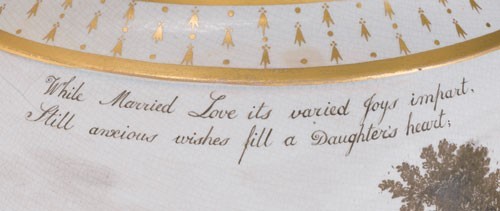
Detail of the hand-painted script on the reverse side of the jug illustrated in fig. 1. (Photo, Gavin Ashworth.)
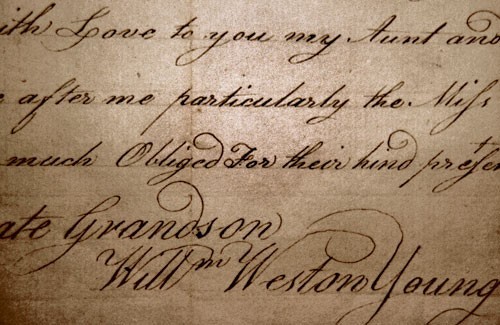
Detail of a document with the handwriting and signature of William Weston Young, a decorator at the Cambrian Pottery in Swansea, Wales, 1803– 1806. (Photo © Jonathan Gray, by permission of Sotheby’s.) There are almost identical characteristics to letters found in the hand-painted inscription on the jug: the uppercase W and L; the lowercase a, which has an upward extension of the right side; and the lowercase d, f, l, p, and t, which are all made with a single stroke. It is, of course, easier to flourish handwriting on paper than painted script on
a ceramic.

Detail of the left-to-right tableaux of Wiscasset, Maine, appearing on the reverse side of the jug illustrated in fig. 1 and its mate in the Maine Historical Society. Even though there are the minor variations in the renderings and in the intensity of pigment to be expected in painted images, the basic design elements are the same.
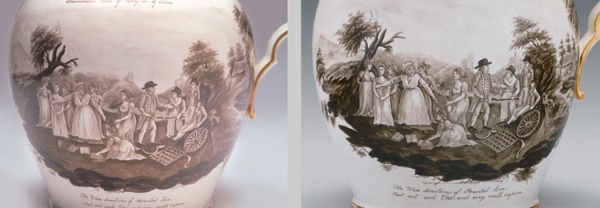
Detail of the left-to-right tableaux of the Barrell family at Barrell Grove, York, Maine, appearing on the obverse side of the jug illustrated in fig. 1 and its mate in the Maine Historical Society. As in those illustrated in fig. 4, there are minor differences in the renderings and in the pigment intensity.
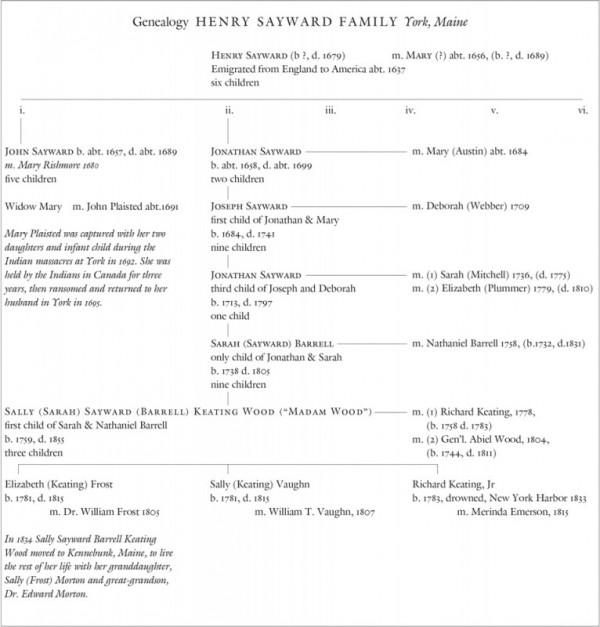
Genealogy of the Henry Sayward family, 1637-1855, of York, Maine.

Lucretia Peabody Hale (1820–1900), Judge Jonathan Sayward House and Wharf, York Harbor, Maine, late nineteenth century. Watercolor on paper. 8 7/8" x 11 1/4". (Courtesy, Historic New England/SPNEA.) Now a museum, the property is owned by Historic New England/SPNEA.

Parlor, Sayward-Wheeler House, York Harbor, Maine. On the walls, from left to right, are portraits of Jonathan Sayward (1713–1797) and his first wife, Sarah (1736–1775), both painted ca. 1760 by the same unidentified artist; and their only child, Sarah Sayward Barrell (1738–1805), painted in 1761 by Joseph Blackburn (1752–1774). (Courtesy, Historic New England/SPNEA.)
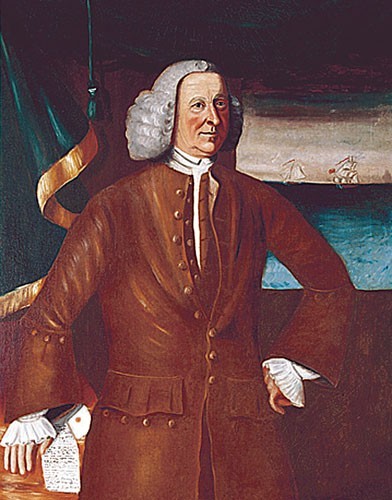
Unidentified artist, Jonathan Sayward (1713–1797), ca. 1760. Oil on canvas. 57" x 46". (Courtesy, Historic New England/SPNEA.)
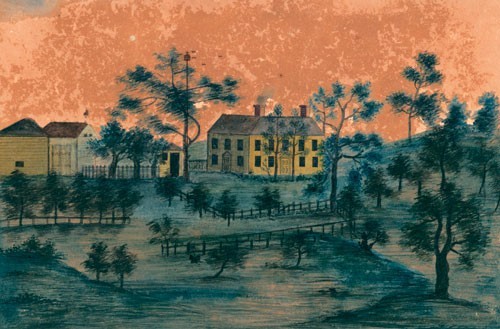
Attributed to Sophia Sewell Munroe (1788–1878), Barrell Grove, York, Maine, ca. 1800. Watercolor on paper. 6" x 8 1/2". Munroe was the first daughter of Ruth Barrell Sewell, who was the second daughter of Nathaniel and Sarah Barrell. (Courtesy, Maine Historical Society, Blaisdell Collection.)

Daguerreotype of Sally (Sarah) Sayward Barrell Keating Wood (1759-1855), probably Portland, Maine, ca. 1845. 2 13/16" x 2 3/8". (Courtesy, Maine Women Writers Collection, University of New England, Portland, Maine.)
In judging the merits of a jug or any other form of Anglo-American historical pottery of the federal period, the quintessential points of connoisseurship to be evaluated are: the rarity and importance of the historical content of the principal designs and their relationship to one another; the artistic qualities, including the rarity of the medium used, enhancements, size, form, and overall aesthetics; the condition; and the factory of origin and history of ownership.
Typically, a fine piece of the ware will excel in only a few of these criteria, but Maine’s early-nineteenth-century pair of Barrell-Wood family jugs excels in all of them (fig. 1). In terms of historical content, the jugs are biographical. They memorialize the lives and times of members of the Nathaniel Barrell family, one of Maine’s wealthiest and most influential families during the eighteenth century, and of Sally Sayward Barrell Keating Wood, Maine’s first woman novelist and America’s first Gothic writer.[1] Thematically, the principal designs are a symphony of subjects. They are skillfully hand painted on a high-quality pearlware body, not transfer-printed. The exceptionally large size of the jugs and their graceful form and rich gold enhancements create magnificent aesthetic appeal. Adding to all those encomiums, both jugs have survived in splendid condition.
Especially distinguishing features are the provenance and history of ownership of the jugs. It is believed that they were made about 1804 at the Cambrian Pottery in Swansea, Wales. A detailed examination comparing their painted designs and script with painted scenes and script found on pieces attributed to William Weston Young, an in-house decorator working at the pottery between 1803 and 1806, shows such similar characteristics as to warrant an attribution of the Barrell-Wood jugs to Young.[2] Even more convincing is the strong similarity between the painted handwriting on the jugs (fig. 2) and Young’s own handwriting as it appears on a document bearing his signature (fig. 3). As for the history of ownership, one jug belonged to Nathaniel Barrell and was in family hands for two centuries at Barrell Grove, the family’s ancestral estate in York, Maine. In 2003 a descendant sold it at auction to the Maine Historical Society.[3] The other jug, which belonged to Nathaniel Barrell’s daughter, Sally Sayward Barrell Keating Wood, was sold by one of her descendants about 1973. It was purchased by the author from a private collector in June 2003. No similar examples are known.
Sally (Sarah) Sayward Barrell Keating Wood (1759–1855) was the eldest child of Nathaniel and Sarah Sayward Barrell. According to Barrell family legend, Sally, who was referred to in later life as “Madam Wood,” sketched the pictorial themes that were copied on the two jugs by an English artisan, presumably William Weston Young. Her drawings show two tableaux of family members and of herself, both framed in pastoral settings. The two vignettes seem to represent the dates of Sally’s two marriages, 1788 and 1804. In addition to documenting family history, then, the jugs must be considered autobiographical. Along with her drawings, Sally sent the English artisan short verses with which to embellish and personalize her artwork. Barrell family tradition also records that the British pottery received its payment in the form of timber that was cut at the family farm and sold in Britain. So even though Sally designed the jugs, her father, Nathaniel Barrell, apparently paid for them.[4]
On October 28, 1804, Sally married her second husband, General Abiel Wood of Wiscasset, Maine. Abiel—Sally’s senior by fifteen years—was a wealthy shipbuilder and shipowner, merchant, and longtime family friend. In a letter to her father dated December 7, 1804, Sally wrote, “Hartly [Abiel’s son] is now in Charlestown and my pitchers upon them.”[5] The reference is probably to one of Abiel’s ships under the command of Hartly. Abiel was engaged in the lumber trade with England and may have arranged the sale of the Barrell Grove timber in England to pay for the special-order jugs. It is believed that Nathaniel Barrell gave one of the jugs to Sally and Abiel, probably as a wedding present, and kept the other for himself.
The scene on the reverse side of the jugs is meant to represent the period that coincides with Sally’s 1804 remarriage. She and her new husband are shown gazing at each other in front of their home in Wiscasset. She is seated and he is standing. Several buildings on the far bank suggest the town of Wiscasset. A three-masted vessel flying an American flag with thirteen stars and stripes is anchored in the adjacent Sheepscot River.
Sally may have intended the scene to symbolize the generations of Saywards, Barrells, Keatings, and Woods—all of whom were engaged in Maine’s maritime trades and commerce, the source of their wealth and social prominence. A young sailor, possibly representing Richard Keating Jr., Sally’s unmarried seafaring son from her first marriage, has just been rowed ashore. He is about to embrace a young lady—his sweetheart and perhaps future wife. In the accompanying verse Sally reflects: “While Married Love its varied joys impart / till anxious wishes fill a daughter’s heart. / And now to gayer scenes she may now rove / Her Mind oft hovers round her native grove” (fig. 4). Undoubtedly, the “native grove” is Barrell Grove, her childhood home.
Although the jugs date from the beginning of the nineteenth century, there is good reason to believe that the time depicted in the tableau on the obverse is about 1778, just before Sally’s first marriage, to Richard Keating. Sally’s sketch for the ceramic artisan shows herself at Barrell Grove with her parents, five sisters, and three brothers. The Agmenticus River (now called York Harbor) and Mount Agmenticus are in the background. Sally is here a young adult and, as such, independent, but she depicts her four younger sisters, who stand behind their mother’s outstretched arms, as still subject to maternal protection, control, and discipline. Ruth, the second oldest daughter, is shown reading, lying on the ground in front of her mother, whose watchful supervision Ruth has not yet escaped.
About 1765 Sally’s father relinquished his maritime commerce for the life of a progressive farmer.[6] He is shown teaching his three sons the latest methods of germination and harvesting, represented symbolically by the farm implements at their feet (fig. 5). As the inscription suggests, Sally’s life at Barrell Grove during that period was real and earnest: “Here Books and work employ each moments time / Unconscious both of Folly and of crime. / The wise directions of parental Love / Rout out each Vice and every month improve.” A barely noticeable canoe with Native Americans appears in both the Wiscasset and Barrell Grove scenes, iconography that pays homage to Sally’s ancestors. Sally was a sixth-generation lineal descendant of Henry Sayward, who immigrated from England to America in 1637, settling first in Hampton, then in Portsmouth, New Hampshire, and finally in York, Maine (fig. 6). Henry had six children, the eldest of whom was John Sayward. When Native Americans attacked York in 1692 and massacred many of its inhabitants, John’s widow, Mary, who had by then married James Plaisted, was taken captive with two of her daughters and a newborn child. They were forced to march to Canada and, en route, the infant was brutally murdered. Three years later Mary was ransomed and returned to her husband in York.[7]
Sally’s father, Nathaniel Barrell (1732–1831), came from an affluent merchant family in Portsmouth, New Hampshire. Her mother, Sarah Sayward (1738–1805), was the only child of Judge Jonathan Sayward (1713–1797) of York, one of Maine’s wealthiest and most influential individuals, who, in addition to being a high-level civil servant, was also a successful merchant, shipbuilder, and shipowner. Nathaniel married Sarah in 1758, and into this wealth and social prominence Sally was born a year later. Shortly after her birth Nathaniel Barrell departed for London on a three-year business trip.
Judge Sayward’s house was considered York’s finest (figs. 7-9). Sayward wanted his daughter, Sarah Sayward Barrell, to have an estate even grander than his own, and after her marriage he acquired about 180 acres of farmland with a dwelling at Beech Ridge outside York. Through renovations and additions to the existing structure, he created a gracious two-story home for his daughter and her new husband. The estate came to be known as Barrell Grove (fig. 10). Sayward kept the title to the property in his name, intending to establish an estate tail that would limit succession to his lawful issue.[8]
When Nathaniel Barrell returned to America in 1763 he brought his young wife and his daughter several elegant pieces of English furniture for their new home as well as the news that he had established important business connections in the mother country. Not only had he gained the favor of the prince who was to take the name George III but he had also been invited to the coronation ceremonies as a representative of the Massachusetts Colony.[9] Soon thereafter Barrell’s countrymen would be dumping the king’s tea in Boston Harbor.
There were serious differences between Sayward and his son-in-law, arising mainly from Nathaniel Barrell’s unorthodox religious beliefs and affiliations. Either while he was in England or soon after his return, Nathaniel had joined the Sandamanians, who believed that “all members of the church were on equal terms, whether elders, pastors, bishops, or laymen.” They practiced kissing and “Love Feasts” to ensure harmony among members, and washed one another’s feet to keep worshipers humble. Perhaps most alarming to Barrell’s father-in-law, “the accommodation of wealth was sanctioned only if it was used to meet the needs of the poor or the necessities of the church.”[10]
Judge Sayward died in 1797, and under the terms of his will Nathaniel Barrell was to be given only “a decent suit of apparel for every part of his body” and the walking cane he had given the judge.[11] To his daughter, Sarah, Sayward gave a life estate in Barrell Grove. When she died, in 1805, title passed to her son, John, who permitted his father, Nathaniel Barrell, to remain in residence there for the rest of his life.
Sally’s early life was divided between Barrell Grove and the nearby home of her Sayward grandparents. During her teens she lived solely with her grandparents. Both family homes were sophisticated hubs of social, cultural, political, and commercial activity. John Hancock, Samuel Adams, General Henry Knox, and many other notables of the day were family friends and visitors. The variety of exposures produced in Sally a worldliness that was most unusual for young ladies of her time.
Sally’s grandfather Sayward is described in an obituary as having “mental powers [that] were strong and brilliant: for although destitute of a liberal education he acquired an extensive knowledge of men and things,”[12] and he instilled in her a lifelong love of history. He was a self-educated man whose library included a wide range of books, periodicals, and newspapers, and Sally was given free run of it. He was, unquestionably, her role model.
It is hardly surprising that in the years leading up to the Revolution, Judge Sayward and his son-in-law Nathaniel Barrell were both outspoken Tories. Their loyalty to the crown made enemies for both men, causing them to suffer substantial financial losses.[13] After the war began, however, their sympathies changed in favor of independence, and they were able to regain the confidence of their townsmen. Sayward was once again appointed to important civil posts, and in 1787 Nathaniel Barrell was elected a delegate to the Massachusetts Constitutional Convention.[14] His support came from a group of men from York, who were strongly anti-federalist, a view Nathaniel shared. Nathaniel’s brother Joseph, an eminently successful Boston merchant and a committed federalist, persuaded Nathaniel to rethink his position and to support ratification of the federal constitution.[15] In so doing, of course, Nathaniel was repudiating the views of the York men who had voted for him.
Like her father and her grandfather, Sally was a loyalist, and the years of war and its aftermath were difficult for her, too. In 1778, at the age of nineteen, she married Richard Keating, a clerk in her grandfather’s maritime office. The young man had shown so much ability in managing Judge Sayward’s business assets that the patriarch had named him executor of his will. Sadly, in 1783, after only five years of marriage, Keating became ill and died. He was only twenty-five years old. Sally was twenty-four, the mother of two young girls, and pregnant with a son, Richard Keating Jr., who, like his father, was fated to an early death.
Judge Sayward had provided a home for the Keating family across a lane from his residence, and after her husband’s death Sally continued living there with her three children, her needs taken care of by her grandfather.[16] As the years wore on she began thinking of ways to earn at least part of her expenses. She had always enjoyed writing and decided that she would write with the express purpose of making money, even though to do so violated the normal expectations both of her family and of polite society. The Barrells, Saywards, Keatings, and Woods—and Sally herself—all firmly believed in the primacy of a woman’s role as daughter, wife, and mother. Her writings “consistently reveal her anxieties about the difficulty for women of balancing vocation and avocation.”[17]
Whether because of her own modesty or because of the wishes of her family, Sally never published under her own name. Before Maine separated from Massachusetts in 1820, she used the pseudonyms “A Lady” and “A Lady from Massachusetts”; after Maine became a state, she called herself “A Lady from Maine.” Despite her moderate success as a novelist, the young widow nevertheless felt compelled to defend her nontraditional vocation, claiming that “not one social, not one domestic duty [had] ever been sacrificed by her pen.”[18]
The fact that the designer of the Barrell-Wood jugs was the first female novelist in Maine—and America’s first Gothic novelist—adds luster and importance to the objects. Thus, it is worthwhile to review the woman’s literary output, which totals five published novels and a group of unpublished manuscripts.
Her first novel, Julia and the Illuminated Baron, A Novel Founded on Recent Facts, Which Have Transpired in the Course of the Late Revolution of Moral Principles in France, was published in 1800, seventeen years after the death of her first husband. The story, a melodrama, is set in France and focuses on the activities of the Free Society of the Illuminati. Sally’s hours spent in her grandfather’s library had not been wasted.
Julia was followed in 1801 by Doval; or, the Speculator: A Novel, Founded on Recent Facts, a fictionalized account of the fraudulent 1796 sale of land in the Yazoo River area in Georgia involving bribes to state legislators.
Amelia; or, the Influences of Virtue: An Old Man’s Story was published in 1802. In 1804, the year of Sally’s second marriage, Ferdinand and Elmira, A Russian Story went to press. Her fifth and final novel, Tales of the Night, was published in 1827 after a hiatus of twenty-three years.[19] While Sally must be considered a groundbreaking woman writer by the standards of her time, it is unlikely that her works would make it to the top of today’s best-seller lists. One scholar dismisses her prose as “symptomatic of the period, painful and formal in phrasing, strong in moralizing on the advantages of Virtue and the dire effects of Vice.”[20] Karen A. Weyler, a leading authority on early American women writers, opines, “Most of Wood’s fictional works explore the trials of unmarried women and conclude once these women understand their family histories and are married to suitable men.” Her fiction “consistently illustrates her engagement with social, political and cultural issues during the early national era, especially her concerns about the impact of national events upon the individual and the family.”[21] Nevertheless, Madam Wood’s five published novels fit the mood of her era, and her refusal to submit to the rigid constraints of society must be seen as spirited, particularly in view of the tragedies that marked much of her life.
For twenty years after the death of her first husband, Sally raised her three children as a single mother. In 1804 her youngest child and only son, Richard Keating Jr., reached his majority and Sally took a second husband, General Abiel Wood. Her happiness was to be short-lived, however. In 1807 President Thomas Jefferson launched an embargo on international trade that caused Abiel’s fortunes to dwindle. In 1811, after only seven years of marriage, he died after an illness, leaving Sally financially insecure and dependent once again on the generosity of her family. In a letter to her brother, Jonathan Sayward Barrell, written soon after Abiel’s death, she remembered her few years with Abiel as the happiest of her life.[22]
In 1816, in her late fifties, Sally moved to Kennebunkport, Maine, to be near her son, who had become a successful sea captain. In 1830, at the age of seventy-two, she moved with her son and his family to New York City, where Richard Jr. began sailing out of the increasingly important port of New York.
Three years later, in 1833, Captain Richard Keating Jr. and his crew were spending a winter night safely at anchor in New York’s harbor. During the night a strong current propelled huge chunks of ice against the hull of his anchored vessel. The ship was broken in two and sank immediately. The captain and all hands perished in the freezing water.[23]
More than any other event in her life, her son’s death caused the old woman unbearable pain. “The loss of her remaining child, an enterprising son, the stay and support of her declining years” was overwhelming.[24] In 1834 Sally (fig. 11) moved back to Kennebunkport, where she lived the remainder of her life with her granddaughter, Sally Frost Morton, and great-grandson, Dr. Edward Morton.
In 1855, at the age of ninety-seven, having outlived two husbands and all three of her children, this remarkable, strong-willed, talented, yet perhaps star-crossed woman died. Her lifetime spanned the French and Indian War, the American Revolution and the birth of our nation, the War of 1812, and the War with Mexico, and in her final days the storm clouds of the American Civil War were gathering.
Madam Wood had lived in interesting times and had captured something of them in her novels. Ironically, it is not her literary efforts, celebrated while she lived, that transport her to our age. It is the Barrell-Wood jugs she designed that make her, those she loved, and the era in which she lived come alive for us today.
These jugs whisper to us of prominent Tories who found redemption. They speak with pride of money made in shipping, agriculture, and mercantile endeavor. They help to tell a story that spans more than three centuries, from an Indian massacre in 1692 all the way to 2003, when a descendant living at Barrell Grove sold Nathaniel Barrell’s jug at auction to the Maine Historical Society. They are more than great examples of Anglo-American historical pottery: they are time capsules that tell of the lives of women a century before women had the vote, and they speak of the uncertainties of our colonial and early federal years. Most of all they illuminate the life of a remarkable human being whose life spanned a century during which the United States was trying to invent itself.
If the luster of these jugs accurately reflects the illustrious life of “Madam Wood,” and if they help to preserve the memory of her historic times, then they are much more than artifacts. Along with their other sterling qualities, they are unique historical documents that help explain our past. In that, their greatness lies.
ACKNOWLEDGMENTS
I am deeply indebted to John Mayer, Curator, Maine Historical Society, who most generously gave me copies of his Sayward and Barrell family research materials. Those documents greatly facilitated the advancement of my own research and the interpretations I express in this article. My special appreciation is extended to Jonathan Gray, an independent scholar and editor of Welsh Ceramics in Context, Part I (2003), who astutely identified the pottery that made the Barrell-Wood jugs, the decorator, and their probable date of manufacture. I am also most grateful to my friend Charles N. Lord, who edited my manuscript, adding color to my writing and enhancing my thoughts.
“Sally (Sarah) Sayward Barrell Keating Wood,” in Maine Writers Index, Waterboro Public Library, available online at www.waterborolibrary.org/maineaut/tz.htm#swood (accessed July 29, 2005).
Jonathan Gray, ed., Welsh Ceramics in Context, Part 1 (Swansea: Royal Institution of South Wales, 2003), pp. 124–31.
Hap Moore Antique Auctions, York, Maine, May 18, 2003.
Maine Writers Research Club, comp., Historic Churches and Homes of Maine (Portland, Me.: Falmouth Book House, 1937), p. 74.
Sally Sayward Barrell Keating Wood to her father, Nathaniel Barrell, December 7, 1804, Blaisdell Collection, Maine Historical Society.
Doris R. Marston, “A Lady of Maine: Sally Sayward Barrell Keating Wood, 1759–1855” (master’s thesis, University of New Hampshire, 1970), p. 49 (copy in the Maine Historical Society Library, Portland).
Charles A. Sayward, The Sayward Family: Being the History and Genealogy of Henry Sayward of York and His Descendants (Ipswich, Mass.: Independent Press, E. G. Hull, 1890), pp. 131–37.
Historic Churches and Homes of Maine, p. 72.
Charles Edward Banks, History of York, Maine, Successively Known as Bristol (1632), Agamenticus (1641), Gorgeana (1642), and York (1652).... 2 vols. (Boston: [Calkins Press], 1931), 1:61.
Marston, “Lady of Maine,” pp. 27, 28.
Sayward, Sayward Family, pp. 65–68.
Ibid., p. 64, quoted from the Columbian Centinel, June 3, 1797.
Banks, History of York, Maine, 1: 398.
Marston, “Lady of Maine,” pp. 101–2.
Ibid., pp. 102–3.
Ibid., pp. 93, 97.
Karen A. Weyler, “Profile: Sally Sayward Barrell Keating Wood, 1758–1855,” in Legacy: A Journal of American Women Writers 15, no. 2 (1998): 209.
Laurel Thatcher Ulrich, “‘From the Fair to the Brave’: Spheres of Womanhood in Federal Maine,” in Agreeable Situations: Society, Commerce and Art in Southern Maine, 1780–1830, edited by Laura Fecych Sprague (Boston: Northeastern University Press, 1987), p. 215.
“Sally (Sarah) Sayward Barrell Keating Wood,” in Maine Writers Index.
Banks, History of York, Maine, 2:406.
Weyler, “Profile,” pp. 204–5.
Sally Sayward Barrell Keating Wood to her brother, Jonathan Sayward Barrell, August 28, 1811, Blaisdell Collection, Maine Historical Society, Portland.
Fannie Scott Chase, Wiscasset in Pownalborough: A History of the Shire Town and the Salient Historical Features of the Territory between the Sheepscot and Kennebec Rivers (Wiscasset, Me.: [Southworth-Anthoensen Press], 1941), p. 573.
Henry E. Dunnack, The Maine Book (Augusta, Me.: N.p., 1920), p. 146.
